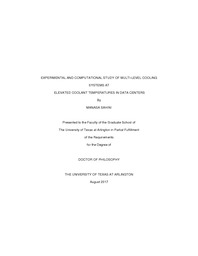
ATTENTION: The works hosted here are being migrated to a new repository that will consolidate resources, improve discoverability, and better show UTA's research impact on the global community. We will update authors as the migration progresses. Please see MavMatrix for more information.
Show simple item record
| dc.contributor.advisor | Agonafer, Dereje | |
| dc.creator | Sahini, Manasa | |
| dc.date.accessioned | 2017-10-02T13:51:25Z | |
| dc.date.available | 2017-10-02T13:51:25Z | |
| dc.date.created | 2017-08 | |
| dc.date.issued | 2017-07-20 | |
| dc.date.submitted | August 2017 | |
| dc.identifier.uri | http://hdl.handle.net/10106/26950 | |
| dc.description.abstract | Data centers house a variety of compute, storage, network IT hardware where equipment reliability is of utmost importance. Heat generated by the IT equipment can substantially reduce its service life if T_(J,Max), maximum temperature that the microelectronic device tolerates to guarantee reliable operation, is exceeded. Hence, data center rooms are bound to maintain continuous conditioning of the cooling medium. This approach often results in over-provisioned cooling systems. In 2014, U.S. Data center electricity consumption is about 1.8% of the total electrical energy in the country. Hence, data center power and cooling have become significant issues facing the IT industry.
The first part of the study focuses on air cooling of electronic equipment at room level. Data centers are predominantly cooled by perimeter computer air handling units that supply cold air to the raised floor plenum and the cold air helps in removing the heat generated by IT equipment. This method tends to be inadequate especially when the average power density per rack rises above 4 kW. As a solution to mitigate this problem, different rack and row based cooling solutions have been proposed and used. The primary focus of these cooling methods is to bring cooling closer to the heat source which is the IT rack thereby improving the heat dissipation process along with controlled air flow management in the data center room. Mostly known close-coupled cooling solutions include rear-door heat exchanger, in-row coolers, and over-head cooling. In this study, a new end-of-aisle close-coupled cooling solution for small data center cooling room has been proposed. As oppose to the existing designs, this design is distinctive in eliminating the risk of placing the liquid on top of IT racks along with achieving cooling energy efficiency. Three different configurations of the proposed designs are studied for its thermal performance using computational modeling.
The second part of the study focuses on liquid cooling at rack level. Liquid cooling addresses the critical issues related to typical air cooling in servers because of its better heat transfer characteristics. Water-cooling at the device level can be an efficient solution since water has higher thermal capacitance when compared to traditional heat carrying medium i.e., air. The emerging practice in the data center industry is to maximize the use of economizer usage by reducing/eliminating the usage of chiller while taking advantage of outside ambient conditions to cool the data centers. Liquid cooled racks are generally designed with different configuration of pumping systems. Empirical study is conducted on a state-of-art liquid cooled electronic rack for high coolant inlet, commonly known as warm-water cooling in order to evaluate the cooling performance of distributed vs. centralized coolant pumping systems. Experimental set up is instrumented such that detailed analysis is employed to study component temperatures as well as cooling performance of the rack at elevated inlet conditions.
The third part of the study focuses on the impact of high server inlet temperatures to static power at server level. In order to maximize the use of economizers, the IT hardware will be exposed to higher inlet temperatures which would lead to higher operating temperatures of the processors. The operating temperature of the CPU has direct influence on the static power due to subthreshold leakage which is known to reduce the performance of the processor. The current work serves as a firsthand investigation to study trade-off between server performance and energy efficiency for elevated inlet temperature in air vs. liquid cooled servers. Air cooled IT along with the liquid cooled counter-parts are instrumented and extensively tested to simulate the high ambient conditions at the test bed data center. | |
| dc.format.mimetype | application/pdf | |
| dc.language.iso | en_US | |
| dc.subject | Data center cooling | |
| dc.subject | Close-coupled cooling solution | |
| dc.subject | Thermal performance | |
| dc.subject | Liquid cooling | |
| dc.subject | Air cooling | |
| dc.subject | Energy efficiency | |
| dc.subject | High ambient inlet temperatures | |
| dc.title | EXPERIMENTAL AND COMPUTATIONAL STUDY OF MULTI-LEVEL COOLING SYSTEMS AT ELEVATED COOLANT TEMPERATURES IN DATA CENTERS | |
| dc.type | Thesis | |
| dc.degree.department | Mechanical and Aerospace Engineering | |
| dc.degree.name | Doctor of Philosophy in Mechanical Engineering | |
| dc.date.updated | 2017-10-02T13:51:25Z | |
| thesis.degree.department | Mechanical and Aerospace Engineering | |
| thesis.degree.grantor | The University of Texas at Arlington | |
| thesis.degree.level | Doctoral | |
| thesis.degree.name | Doctor of Philosophy in Mechanical Engineering | |
| dc.type.material | text | |
Files in this item
- Name:
- SAHINI-DISSERTATION-2017.pdf
- Size:
- 2.622Mb
- Format:
- PDF
This item appears in the following Collection(s)
Show simple item record


